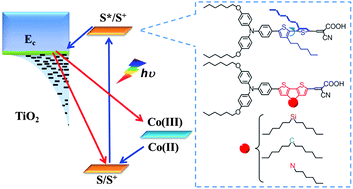The rigidification of π-conjugated segments represents a feasible tactic towards energy-level engineering of organic D-π-A dyes in mesoscopic titania solar cells. In this work, comparions of four dyes with the di(3-hexylthiophene), dihexyldithienosilole, dihexylcyclopentadithiophene and N-hexyldithienopyrrole linkers have revealed some general influences of π-linker rigidification on the optoelectronic features of titania solar cells employing a cobalt(II/III) redox electrolyte, in terms of energetic and kinetic viewpoints. Compared to a dye with the di(3-hexylthiophene) linker, its three counterparts with rigidified dithiophene blocks present bathochromic and hyperchromic absorptions of solar photons. Transient absorption measurements have shown that the incorporation of Si-, C- and N-bridged dithiophene segments decelerates the dye regeneration kinetics. The rigidification of π-conjugated dithiophene linkers brings forth a general open-circuit photovoltage diminishment, in the range from 60 to 190 mV. Further insightful impedance analyses have disclosed that the open-circuit photovoltage reduction, due to the π-linker alternation from di(3-hexylthiophene) to N-hexyldithienopyrrole, is predominantly caused by an adverse downward displacement of the titania conduction band edge, despite a positive contribution from attenuated charge recombination at the titania/electrolyte interface.

You have access to this article
 Please wait while we load your content...
Something went wrong. Try again?
Please wait while we load your content...
Something went wrong. Try again?


 Please wait while we load your content...
Please wait while we load your content...